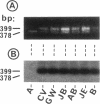Abstract
By the careful screening of familial dysbetalipoproteinemic (FD) patients, five probands showing heterozygosity for the APOE*3-Leiden allele were found. Genealogical studies revealed that these probands share common ancestry in the 17th century. In a group of 128 family members, spanning three generations, 37 additional heterozygous APOE*3-Leiden gene carriers were detected. Although with a variable degree of severity, all carriers exhibited characteristics of FD such as (a) elevated levels of cholesterol in the very low density lipoprotein (VLDL) and intermediate density lipoprotein (IDL) fractions, (b) elevated ratios of cholesterol levels in these density fractions over total plasma levels of triglycerides, and (c) strongly increased plasma levels of apolipoprotein E (apoE). Multiple linear regression analysis revealed that most of the variability in expression of FD in APOE*3-Leiden allele carriers can be explained by age. Body mass index showed a less significant influence on the expression of FD. Gender had no effect on the expression in E*3-Leiden allele carriers, nor did it influence the age of onset of FD. In the group of APOE*3-Leiden allele carriers, we found that the E*2 allele enhances the expression of FD, whereas the E*4 allele had the opposite effect. Isoelectric focusing of plasma and of isolated VLDL, IDL, and high density lipoprotein density fractions showed that in E*3-Leiden allele carriers the apoE3-Leiden variant largely predominates over its normal apoE counterpart, especially in the VLDL and IDL density fractions. We conclude that in APOE*3-Leiden allele carriers FD is dominantly inherited with a high rate of penetrance, i.e., the presence of normally functioning apoE molecules in the plasma does not prevent the age-related expression of this disease.
Full text
PDF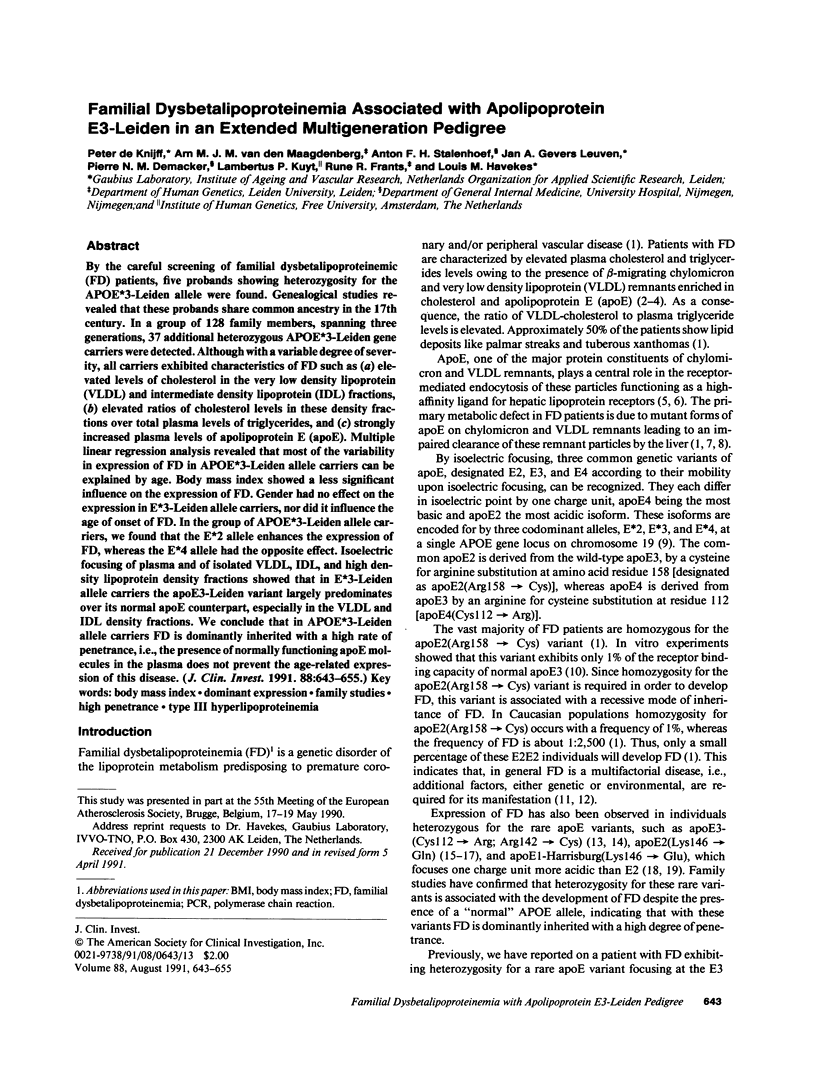
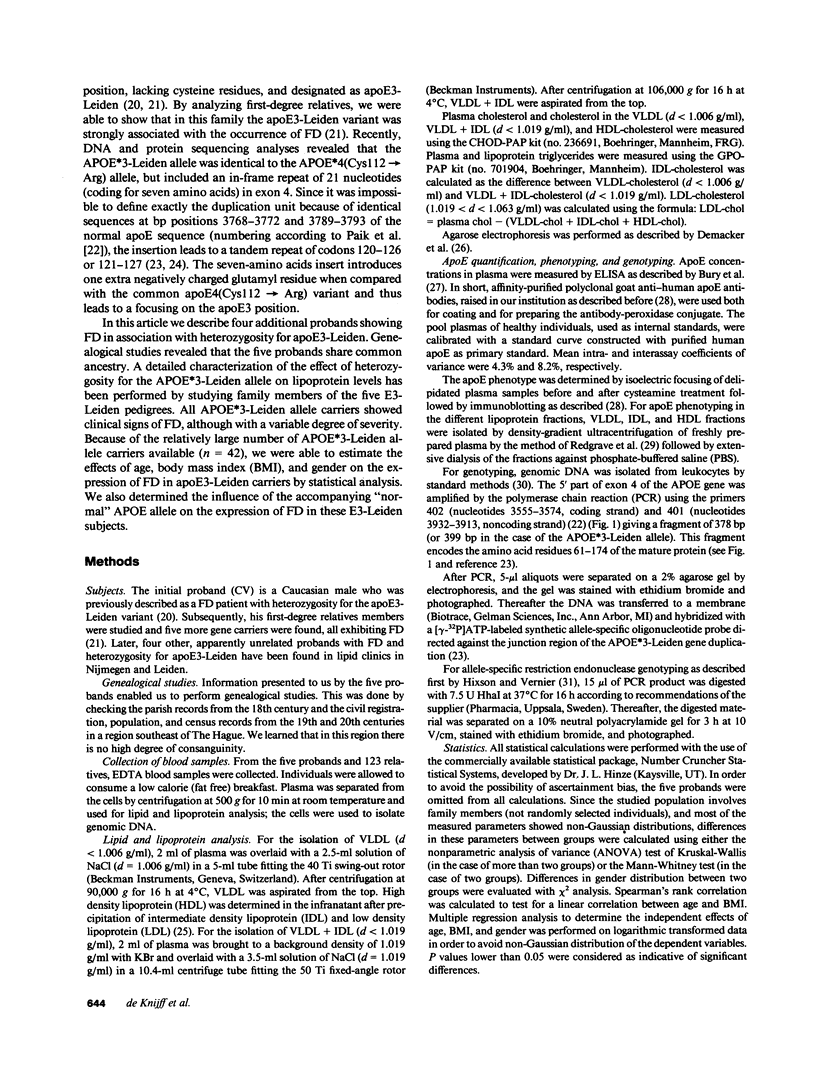
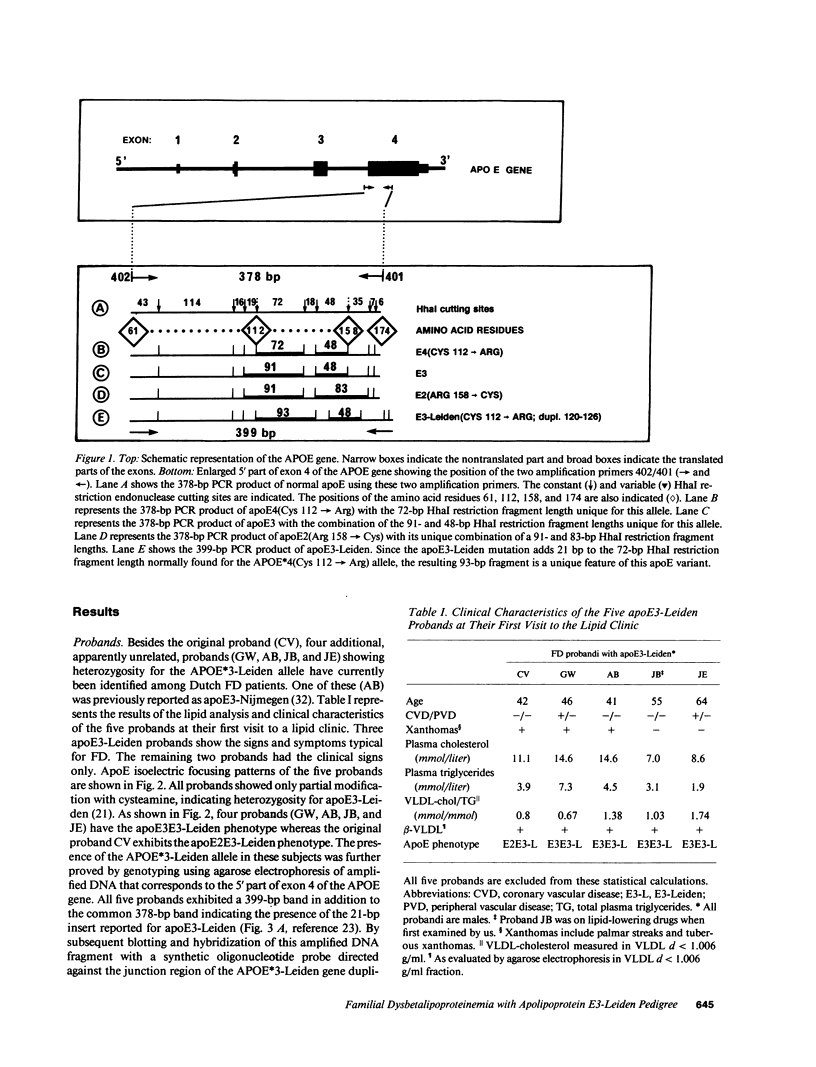
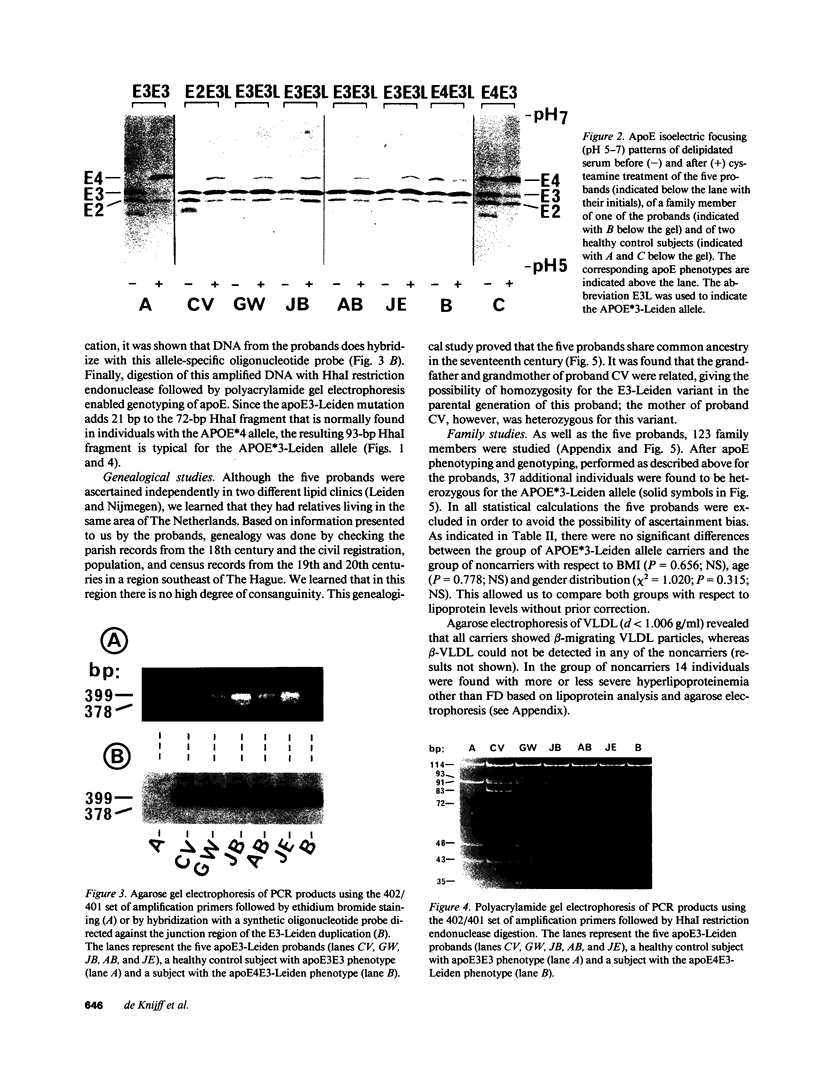
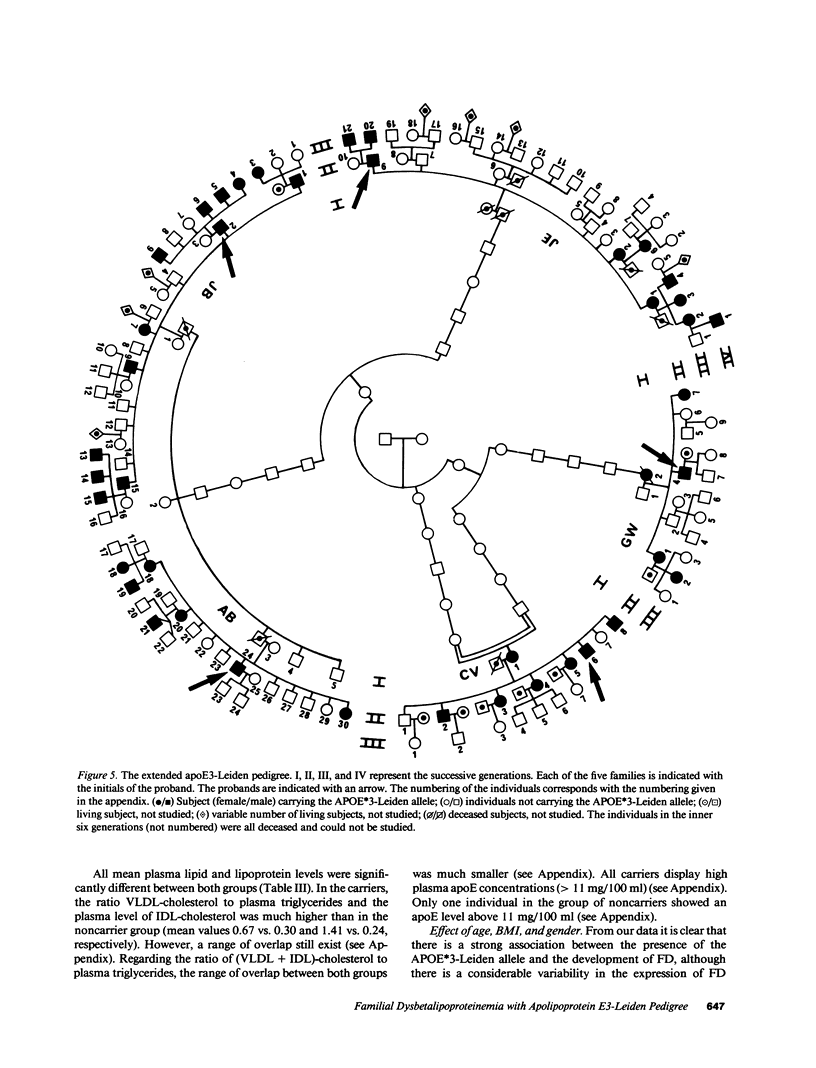
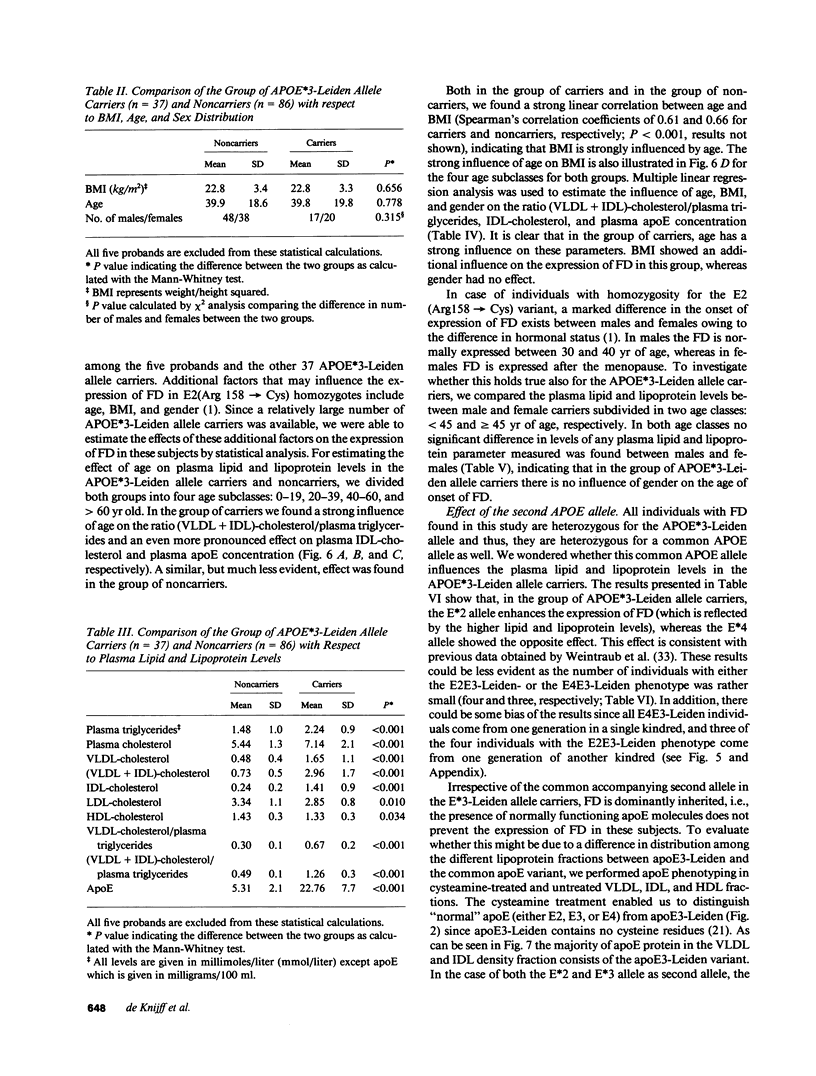
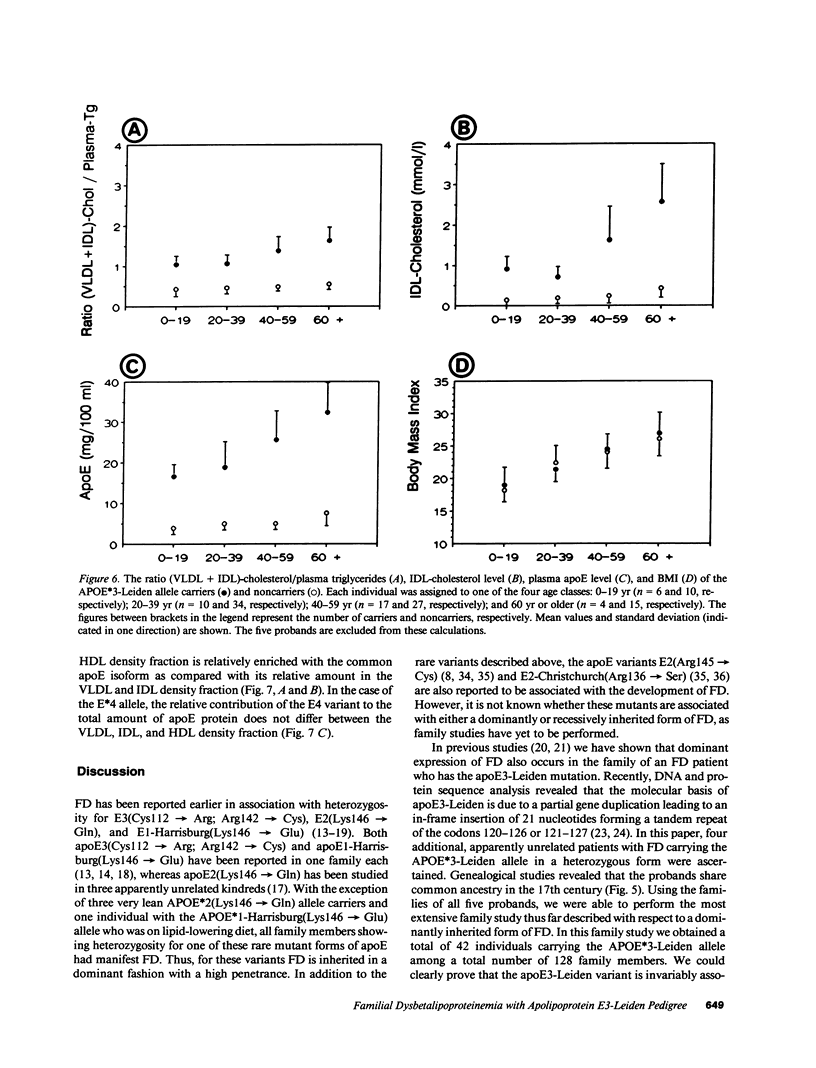
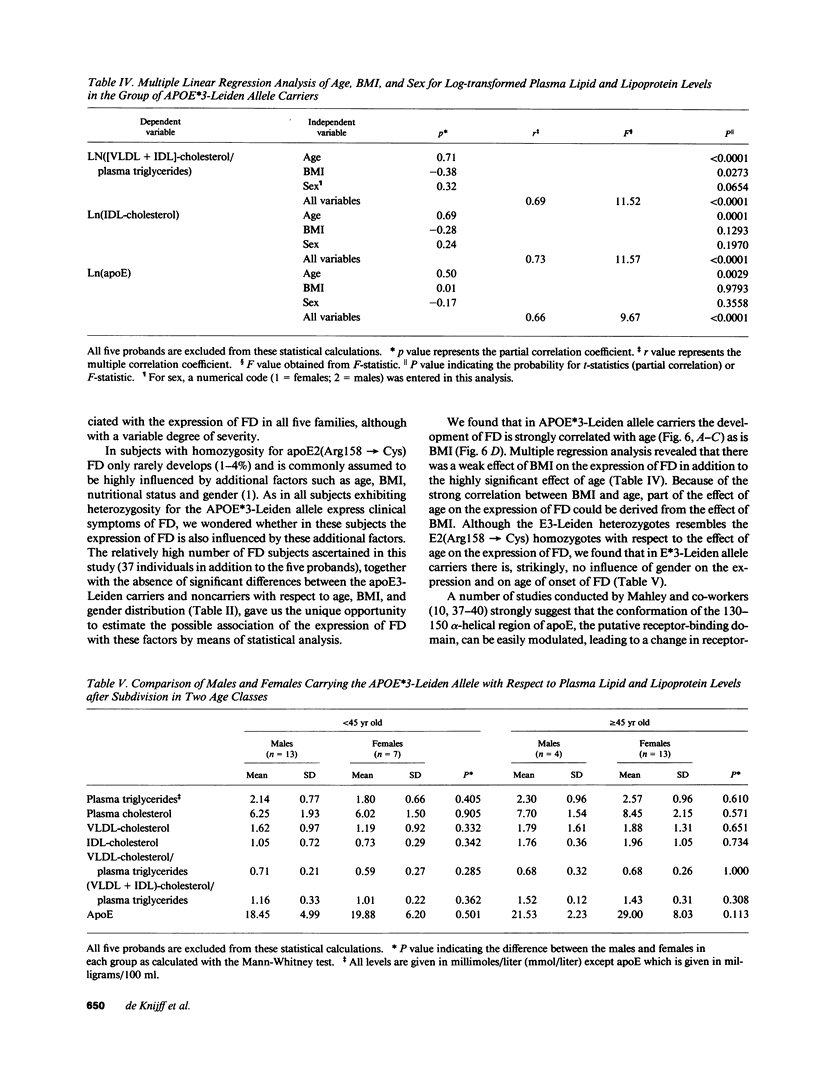
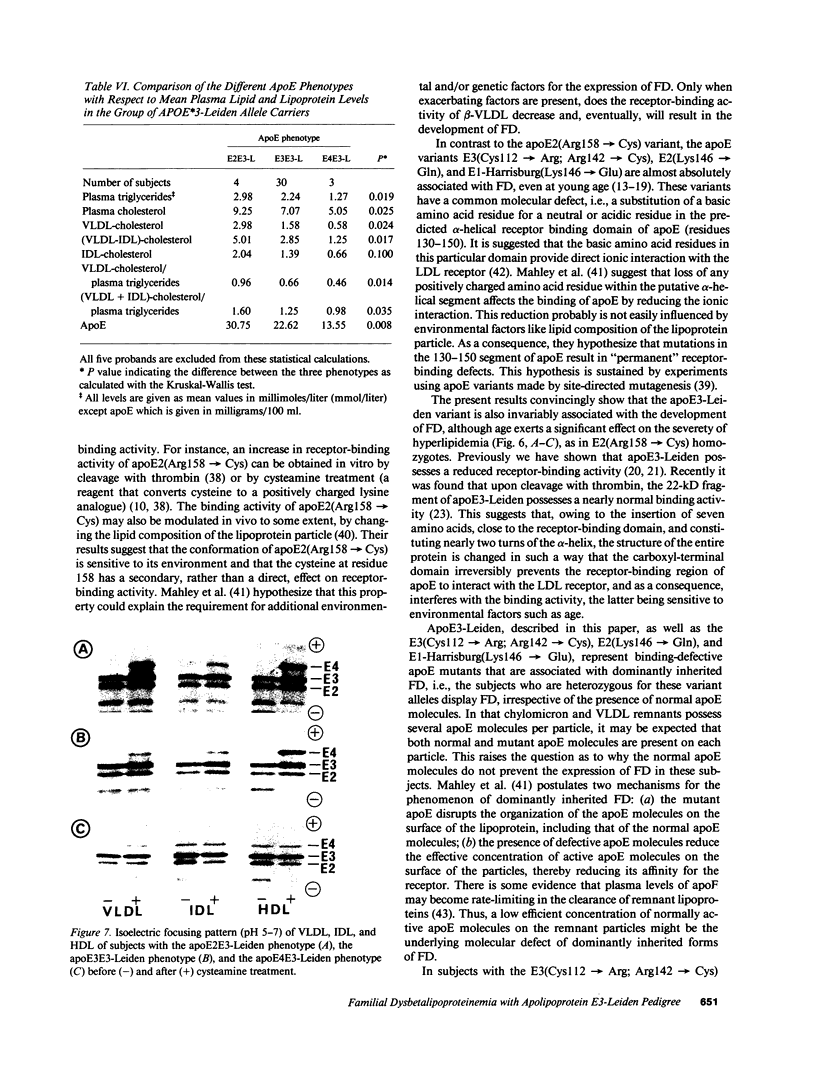
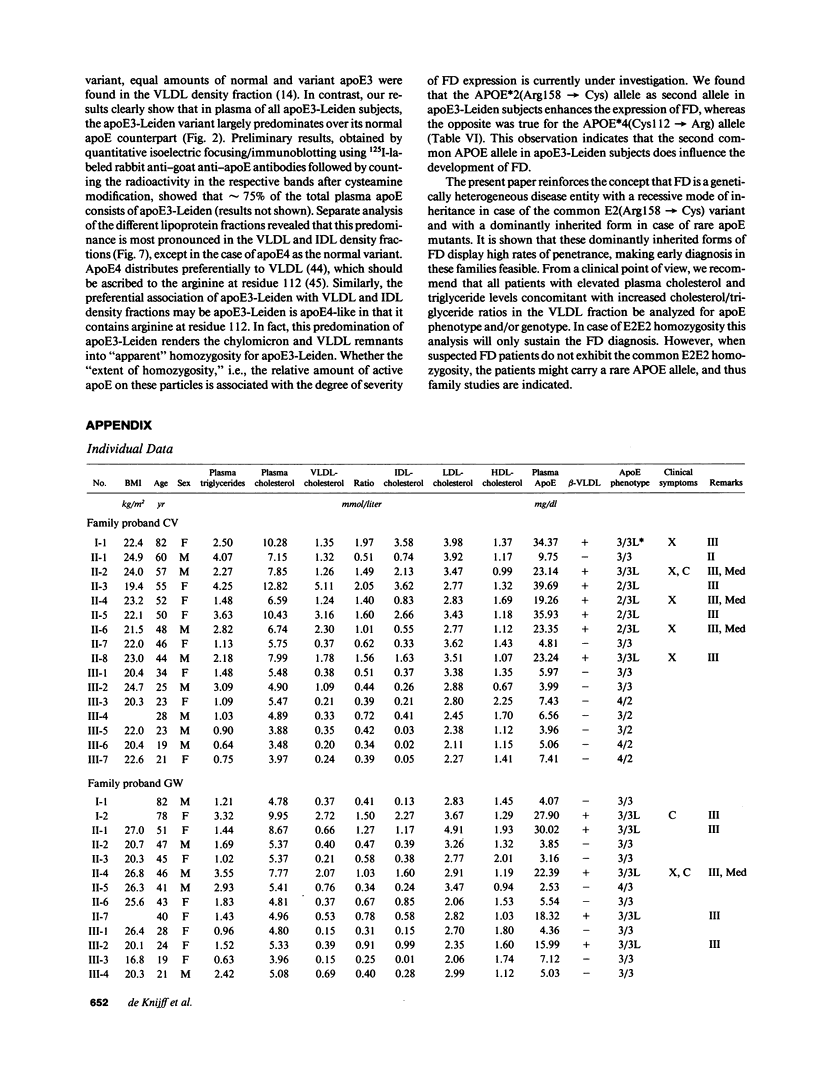
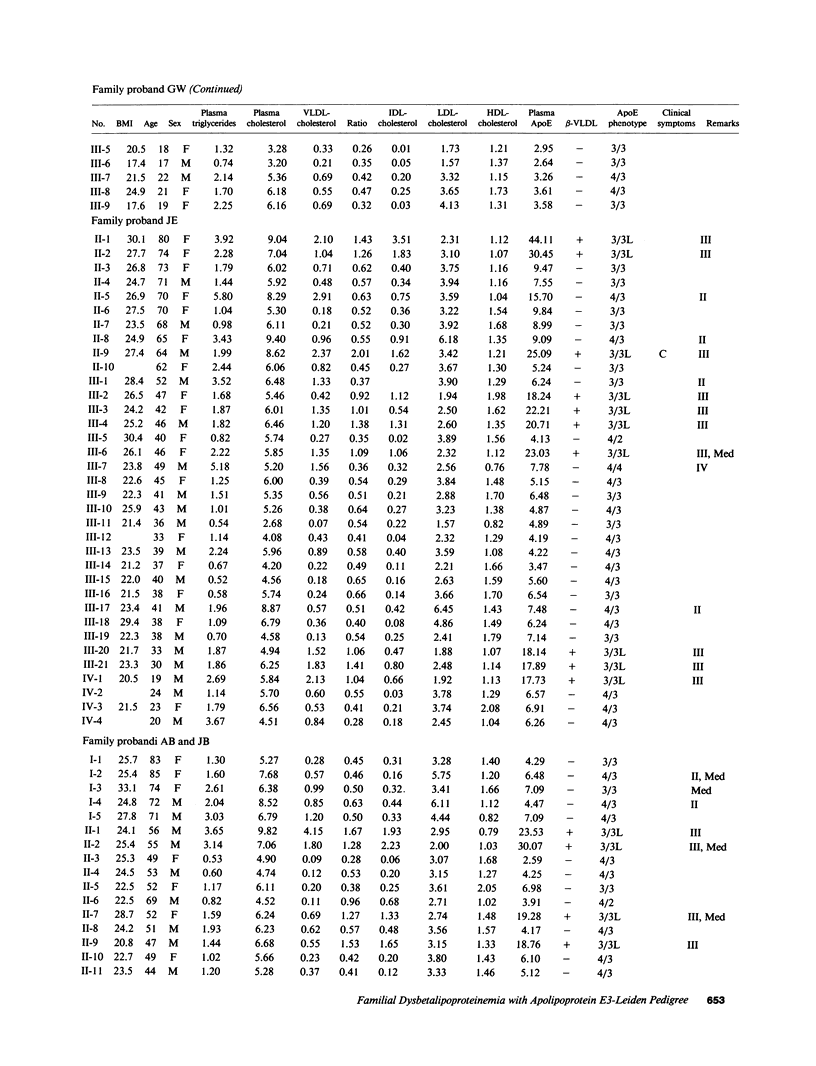
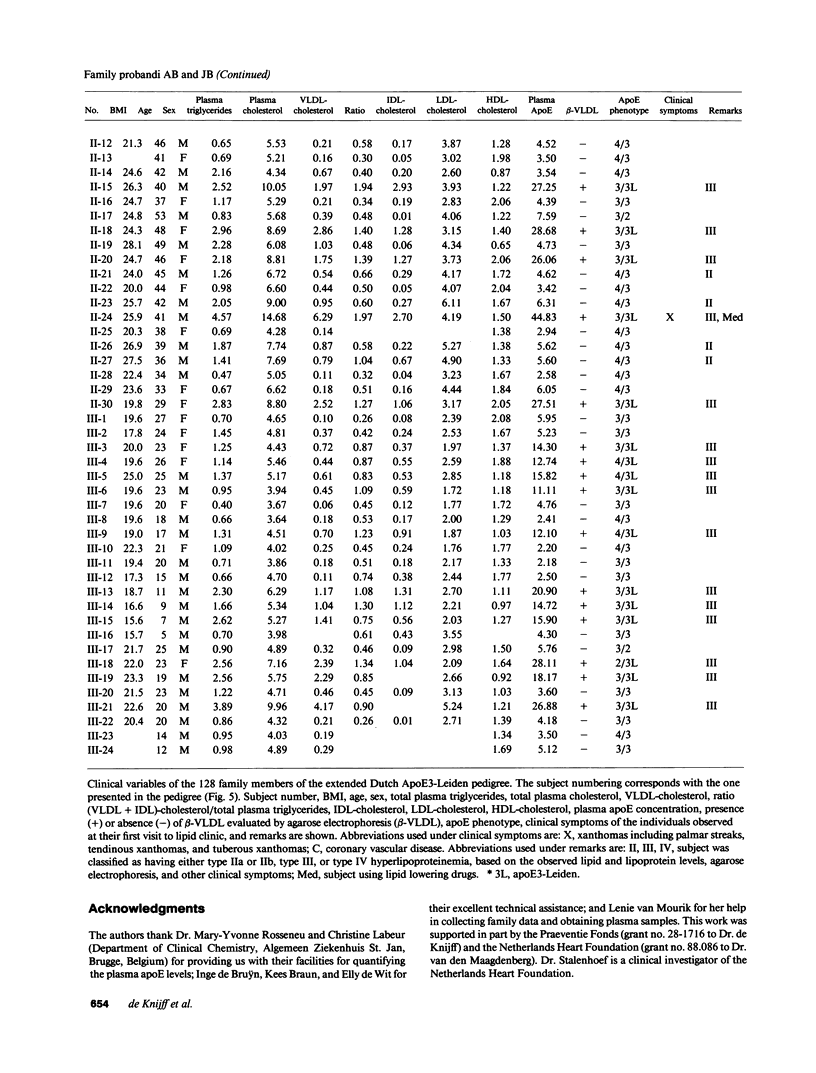
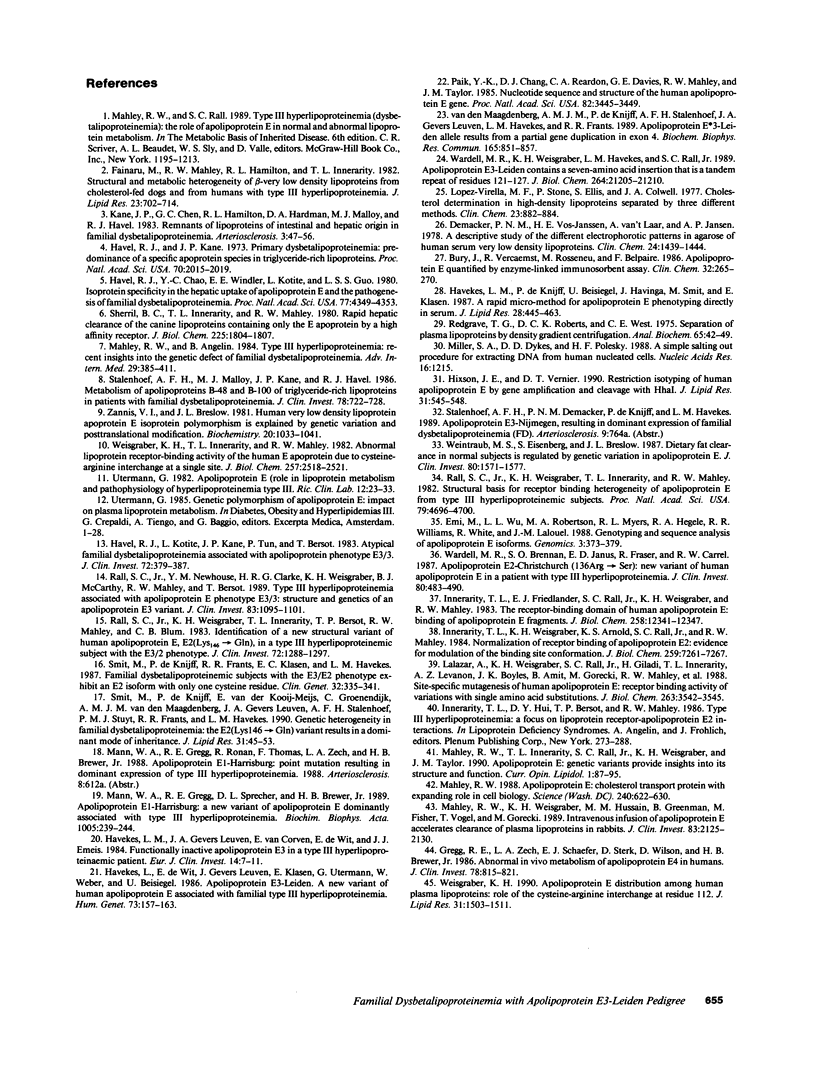
Images in this article
Selected References
These references are in PubMed. This may not be the complete list of references from this article.
- Bury J., Vercaemst R., Rosseneu M., Belpaire F. Apolipoprotein E quantified by enzyme-linked immunosorbent assay. Clin Chem. 1986 Feb;32(2):265–270. [PubMed] [Google Scholar]
- Demacker P. N., Vos-Janssen H. E., van 't Laar A., Jansen A. P. A descriptive study of the different electrophoretic patterns on agarose of human serum very-low-density lipoproteins. Clin Chem. 1978 Sep;24(9):1439–1444. [PubMed] [Google Scholar]
- Emi M., Wu L. L., Robertson M. A., Myers R. L., Hegele R. A., Williams R. R., White R., Lalouel J. M. Genotyping and sequence analysis of apolipoprotein E isoforms. Genomics. 1988 Nov;3(4):373–379. doi: 10.1016/0888-7543(88)90130-9. [DOI] [PubMed] [Google Scholar]
- Fainaru M., Mahley R. W., Hamilton R. L., Innerarity T. L. Structural and metabolic heterogeneity of beta-very low density lipoproteins from cholesterol-fed dogs and from humans with type III hyperlipoproteinemia. J Lipid Res. 1982 Jul;23(5):702–714. [PubMed] [Google Scholar]
- Gregg R. E., Zech L. A., Schaefer E. J., Stark D., Wilson D., Brewer H. B., Jr Abnormal in vivo metabolism of apolipoprotein E4 in humans. J Clin Invest. 1986 Sep;78(3):815–821. doi: 10.1172/JCI112645. [DOI] [PMC free article] [PubMed] [Google Scholar]
- Havekes L. M., Gevers Leuven J. A., van Corven E., de Wit E., Emeis J. J. Functionally inactive apolipoprotein E3 in a type III hyperlipoproteinaemic patient. Eur J Clin Invest. 1984 Feb;14(1):7–11. doi: 10.1111/j.1365-2362.1984.tb00696.x. [DOI] [PubMed] [Google Scholar]
- Havekes L. M., de Knijff P., Beisiegel U., Havinga J., Smit M., Klasen E. A rapid micromethod for apolipoprotein E phenotyping directly in serum. J Lipid Res. 1987 Apr;28(4):455–463. [PubMed] [Google Scholar]
- Havekes L., de Wit E., Leuven J. G., Klasen E., Utermann G., Weber W., Beisiegel U. Apolipoprotein E3-Leiden. A new variant of human apolipoprotein E associated with familial type III hyperlipoproteinemia. Hum Genet. 1986 Jun;73(2):157–163. doi: 10.1007/BF00291607. [DOI] [PubMed] [Google Scholar]
- Havel R. J., Chao Y., Windler E. E., Kotite L., Guo L. S. Isoprotein specificity in the hepatic uptake of apolipoprotein E and the pathogenesis of familial dysbetalipoproteinemia. Proc Natl Acad Sci U S A. 1980 Jul;77(7):4349–4353. doi: 10.1073/pnas.77.7.4349. [DOI] [PMC free article] [PubMed] [Google Scholar]
- Havel R. J., Kane J. P. Primary dysbetalipoproteinemia: predominance of a specific apoprotein species in triglyceride-rich lipoproteins. Proc Natl Acad Sci U S A. 1973 Jul;70(7):2015–2019. doi: 10.1073/pnas.70.7.2015. [DOI] [PMC free article] [PubMed] [Google Scholar]
- Havel R. J., Kotite L., Kane J. P., Tun P., Bersot T. Atypical familial dysbetalipoproteinemia associated with apolipoprotein phenotype E3/3. J Clin Invest. 1983 Jul;72(1):379–387. doi: 10.1172/JCI110978. [DOI] [PMC free article] [PubMed] [Google Scholar]
- Hixson J. E., Vernier D. T. Restriction isotyping of human apolipoprotein E by gene amplification and cleavage with HhaI. J Lipid Res. 1990 Mar;31(3):545–548. [PubMed] [Google Scholar]
- Innerarity T. L., Friedlander E. J., Rall S. C., Jr, Weisgraber K. H., Mahley R. W. The receptor-binding domain of human apolipoprotein E. Binding of apolipoprotein E fragments. J Biol Chem. 1983 Oct 25;258(20):12341–12347. [PubMed] [Google Scholar]
- Innerarity T. L., Hui D. Y., Bersot T. P., Mahley R. W. Type III hyperlipoproteinemia: a focus on lipoprotein receptor-apolipoprotein E2 interactions. Adv Exp Med Biol. 1986;201:273–288. doi: 10.1007/978-1-4684-1262-8_24. [DOI] [PubMed] [Google Scholar]
- Innerarity T. L., Weisgraber K. H., Arnold K. S., Rall S. C., Jr, Mahley R. W. Normalization of receptor binding of apolipoprotein E2. Evidence for modulation of the binding site conformation. J Biol Chem. 1984 Jun 10;259(11):7261–7267. [PubMed] [Google Scholar]
- Kane J. P., Chen G. C., Hamilton R. L., Hardman D. A., Malloy M. J., Havel R. J. Remnants of lipoproteins of intestinal and hepatic origin in familial dysbetalipoproteinemia. Arteriosclerosis. 1983 Jan-Feb;3(1):47–56. doi: 10.1161/01.atv.3.1.47. [DOI] [PubMed] [Google Scholar]
- Lalazar A., Weisgraber K. H., Rall S. C., Jr, Giladi H., Innerarity T. L., Levanon A. Z., Boyles J. K., Amit B., Gorecki M., Mahley R. W. Site-specific mutagenesis of human apolipoprotein E. Receptor binding activity of variants with single amino acid substitutions. J Biol Chem. 1988 Mar 15;263(8):3542–3545. [PubMed] [Google Scholar]
- Lopes-Virella M. F., Stone P., Ellis S., Colwell J. A. Cholesterol determination in high-density lipoproteins separated by three different methods. Clin Chem. 1977 May;23(5):882–884. [PubMed] [Google Scholar]
- Mahley R. W., Angelin B. Type III hyperlipoproteinemia: recent insights into the genetic defect of familial dysbetalipoproteinemia. Adv Intern Med. 1984;29:385–411. [PubMed] [Google Scholar]
- Mahley R. W. Apolipoprotein E: cholesterol transport protein with expanding role in cell biology. Science. 1988 Apr 29;240(4852):622–630. doi: 10.1126/science.3283935. [DOI] [PubMed] [Google Scholar]
- Mahley R. W., Weisgraber K. H., Hussain M. M., Greenman B., Fisher M., Vogel T., Gorecki M. Intravenous infusion of apolipoprotein E accelerates clearance of plasma lipoproteins in rabbits. J Clin Invest. 1989 Jun;83(6):2125–2130. doi: 10.1172/JCI114126. [DOI] [PMC free article] [PubMed] [Google Scholar]
- Mann W. A., Gregg R. E., Sprecher D. L., Brewer H. B., Jr Apolipoprotein E-1Harrisburg: a new variant of apolipoprotein E dominantly associated with type III hyperlipoproteinemia. Biochim Biophys Acta. 1989 Oct 17;1005(3):239–244. doi: 10.1016/0005-2760(89)90043-x. [DOI] [PubMed] [Google Scholar]
- Miller S. A., Dykes D. D., Polesky H. F. A simple salting out procedure for extracting DNA from human nucleated cells. Nucleic Acids Res. 1988 Feb 11;16(3):1215–1215. doi: 10.1093/nar/16.3.1215. [DOI] [PMC free article] [PubMed] [Google Scholar]
- Paik Y. K., Chang D. J., Reardon C. A., Davies G. E., Mahley R. W., Taylor J. M. Nucleotide sequence and structure of the human apolipoprotein E gene. Proc Natl Acad Sci U S A. 1985 May;82(10):3445–3449. doi: 10.1073/pnas.82.10.3445. [DOI] [PMC free article] [PubMed] [Google Scholar]
- Rall S. C., Jr, Newhouse Y. M., Clarke H. R., Weisgraber K. H., McCarthy B. J., Mahley R. W., Bersot T. P. Type III hyperlipoproteinemia associated with apolipoprotein E phenotype E3/3. Structure and genetics of an apolipoprotein E3 variant. J Clin Invest. 1989 Apr;83(4):1095–1101. doi: 10.1172/JCI113988. [DOI] [PMC free article] [PubMed] [Google Scholar]
- Rall S. C., Jr, Weisgraber K. H., Innerarity T. L., Bersot T. P., Mahley R. W., Blum C. B. Identification of a new structural variant of human apolipoprotein E, E2(Lys146 leads to Gln), in a type III hyperlipoproteinemic subject with the E3/2 phenotype. J Clin Invest. 1983 Oct;72(4):1288–1297. doi: 10.1172/JCI111085. [DOI] [PMC free article] [PubMed] [Google Scholar]
- Rall S. C., Jr, Weisgraber K. H., Innerarity T. L., Mahley R. W. Structural basis for receptor binding heterogeneity of apolipoprotein E from type III hyperlipoproteinemic subjects. Proc Natl Acad Sci U S A. 1982 Aug;79(15):4696–4700. doi: 10.1073/pnas.79.15.4696. [DOI] [PMC free article] [PubMed] [Google Scholar]
- Redgrave T. G., Roberts D. C., West C. E. Separation of plasma lipoproteins by density-gradient ultracentrifugation. Anal Biochem. 1975 May 12;65(1-2):42–49. doi: 10.1016/0003-2697(75)90488-1. [DOI] [PubMed] [Google Scholar]
- Sherrill B. C., Innerarity T. L., Mahley R. W. Rapid hepatic clearance of the canine lipoproteins containing only the E apoprotein by a high affinity receptor. Identity with the chylomicron remnant transport process. J Biol Chem. 1980 Mar 10;255(5):1804–1807. [PubMed] [Google Scholar]
- Smit M., de Knijff P., Frants R. R., Klasen E. C., Havekes L. M. Familial dysbetalipoproteinemic subjects with the E3/E2 phenotype exhibit an E2 isoform with only one cysteine residue. Clin Genet. 1987 Nov;32(5):335–341. doi: 10.1111/j.1399-0004.1987.tb03298.x. [DOI] [PubMed] [Google Scholar]
- Smit M., de Knijff P., van der Kooij-Meijs E., Groenendijk C., van den Maagdenberg A. M., Gevers Leuven J. A., Stalenhoef A. F., Stuyt P. M., Frants R. R., Havekes L. M. Genetic heterogeneity in familial dysbetalipoproteinemia. The E2(lys146----gln) variant results in a dominant mode of inheritance. J Lipid Res. 1990 Jan;31(1):45–53. [PubMed] [Google Scholar]
- Stalenhoef A. F., Malloy M. J., Kane J. P., Havel R. J. Metabolism of apolipoproteins B-48 and B-100 of triglyceride-rich lipoproteins in patients with familial dysbetalipoproteinemia. J Clin Invest. 1986 Sep;78(3):722–728. doi: 10.1172/JCI112632. [DOI] [PMC free article] [PubMed] [Google Scholar]
- Utermann G. Apolipoprotein E (role in lipoprotein metabolism and pathophysiology of hyperlipoproteinemia type III). Ric Clin Lab. 1982 Jan-Mar;12(1):23–30. [PubMed] [Google Scholar]
- Wardell M. R., Brennan S. O., Janus E. D., Fraser R., Carrell R. W. Apolipoprotein E2-Christchurch (136 Arg----Ser). New variant of human apolipoprotein E in a patient with type III hyperlipoproteinemia. J Clin Invest. 1987 Aug;80(2):483–490. doi: 10.1172/JCI113096. [DOI] [PMC free article] [PubMed] [Google Scholar]
- Wardell M. R., Weisgraber K. H., Havekes L. M., Rall S. C., Jr Apolipoprotein E3-Leiden contains a seven-amino acid insertion that is a tandem repeat of residues 121-127. J Biol Chem. 1989 Dec 15;264(35):21205–21210. [PubMed] [Google Scholar]
- Weintraub M. S., Eisenberg S., Breslow J. L. Dietary fat clearance in normal subjects is regulated by genetic variation in apolipoprotein E. J Clin Invest. 1987 Dec;80(6):1571–1577. doi: 10.1172/JCI113243. [DOI] [PMC free article] [PubMed] [Google Scholar]
- Weisgraber K. H. Apolipoprotein E distribution among human plasma lipoproteins: role of the cysteine-arginine interchange at residue 112. J Lipid Res. 1990 Aug;31(8):1503–1511. [PubMed] [Google Scholar]
- Weisgraber K. H., Innerarity T. L., Mahley R. W. Abnormal lipoprotein receptor-binding activity of the human E apoprotein due to cysteine-arginine interchange at a single site. J Biol Chem. 1982 Mar 10;257(5):2518–2521. [PubMed] [Google Scholar]
- Zannis V. I., Breslow J. L. Human very low density lipoprotein apolipoprotein E isoprotein polymorphism is explained by genetic variation and posttranslational modification. Biochemistry. 1981 Feb 17;20(4):1033–1041. doi: 10.1021/bi00507a059. [DOI] [PubMed] [Google Scholar]
- van den Maagdenberg A. M., de Knijff P., Stalenhoef A. F., Gevers Leuven J. A., Havekes L. M., Frants R. R. Apolipoprotein E*3-Leiden allele results from a partial gene duplication in exon 4. Biochem Biophys Res Commun. 1989 Dec 15;165(2):851–857. doi: 10.1016/s0006-291x(89)80044-0. [DOI] [PubMed] [Google Scholar]




